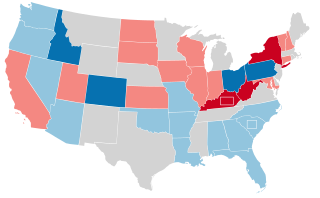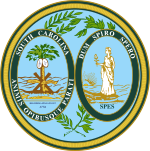
The 1968 United States Senate elections were elections for the United States Senate. Held on November 5, the 34 seats of Class 3 were contested in regular elections. They coincided with the presidential election of the same year. The Republicans picked up five net seats in the Senate. This saw Republicans win a Senate seat in Florida for the first time since Reconstruction.

The 1966 United States Senate elections were elections on November 8, 1966 for the United States Senate which occurred midway through the second term of President Lyndon B. Johnson. The 33 seats of Class 2 were contested in regular elections. Special elections were also held to fill vacancies. With divisions in the Democratic base over the Vietnam War, and with the traditional mid-term advantage of the party not holding the presidency, the Republicans took three Democratic seats, thereby breaking Democrats' 2/3rds supermajority. Despite Republican gains, the balance remained overwhelmingly in favor of the Democrats, who retained a 64–36 majority. Democrats were further reduced to 63-37, following the death of Robert F. Kennedy in June 1968.

The 1962 United States Senate elections was an election for the United States Senate. Held on November 6, the 34 seats of Class 3 were contested in regular elections. Special elections were also held to fill vacancies. They occurred in the middle of President John F. Kennedy's term. His Democratic Party made a net gain of four seats from the Republicans, increasing their control of the Senate to 68-32. However, this was reduced to 67-33 between the election and the next Congress, as on November 18, 1962, Democrat Dennis Chávez, who was not up for election that year, died. He was replaced on November 30, 1962, by Republican appointee Edwin L. Mechem. Additionally, Democrat Strom Thurmond became a Republican in 1964, further reducing Democrats to 66-34. This was the first time since 1932 that Democrats gained seats in this class of Senators.

The 1956 United States Senate elections were elections for the United States Senate that coincided with the re-election of President Dwight D. Eisenhower. The 32 seats of Class 3 were contested in regular elections, and three special elections were held to fill vacancies. Although Democrats gained two seats in regular elections, the Republicans gained two seats in special elections, leaving the party balance of the chamber unchanged.

The 1954 United States Senate elections was a midterm election in the first term of Dwight D. Eisenhower's presidency. The 32 Senate seats of Class 2 were contested in regular elections, and six special elections were held to fill vacancies. Eisenhower's Republican party lost a net of two seats to the Democratic opposition. This small change was just enough to give Democrats control of the chamber with the support of an Independent who agreed to caucus with them, he later officially joined the party in April 1955.

The 1912–13 United States Senate elections were held on various dates in various states. They were the last U.S. Senate elections before the ratification of the Seventeenth Amendment in 1913, establishing direct elections for all Senate seats. Senators had been primarily chosen by state legislatures. Senators were elected over a wide range of time throughout 1912 and 1913, and a seat may have been filled months late or remained vacant due to legislative deadlock. Some states elected their senators directly even before passage of Seventeenth Amendment. Oregon pioneered direct election and experimented with different measures over several years until it succeeded in 1907. Soon after, Nebraska followed suit and laid the foundation for other states to adopt measures reflecting the people's will. By 1912, as many as 29 states elected senators either as nominees of their party's primary or in conjunction with a general election.

The 1908 South Carolina gubernatorial election was held on November 3, 1908, to select the governor of the state of South Carolina. Governor Martin Frederick Ansel faced state senator Coleman Livingston Blease in the Democratic primary and emerged victorious to win a second two-year term as governor.

The 1944 South Carolina United States Senate election was held on November 7, 1944 to select the U.S. Senator from the state of South Carolina.

The 1938 South Carolina United States Senate election was held on November 8, 1938, to select the U.S. Senator from the state of South Carolina. Incumbent Democratic Senator Ellison D. Smith defeated Governor Olin D. Johnston in the Democratic primary. The general election was contested, but a victory by Smith was never in doubt.

The 1920 South Carolina United States Senate election was held on November 2, 1920 to select the U.S. Senator from the state of South Carolina. Incumbent Democratic Senator Ellison D. Smith won the Democratic primary and was unopposed in the general election to win another six-year term.

The 1926 South Carolina United States Senate election was held on November 2, 1926, to select the U.S. Senator from the state of South Carolina. Incumbent Democratic Senator Ellison D. Smith won the Democratic primary and was unopposed in the general election to win another six-year term.

The 1932 United States Senate election in South Carolina was held on November 8.

The 1930 South Carolina United States Senate election was held on November 4, 1930, to select the U.S. Senator from the state of South Carolina. Incumbent Democratic Senator Coleman Livingston Blease was defeated in the Democratic primary by James F. Byrnes. He was unopposed in the general election to win a six-year term.

The 1936 South Carolina United States Senate election was held on November 2, 1936 to select the U.S. Senator from the state of South Carolina. Incumbent Democratic Senator James F. Byrnes won the Democratic primary and defeated two Republican candidates in the general election to win another six-year term.

The 1942 South Carolina United States Senate election was held on November 3, 1942 to select the U.S. Senator from the state of South Carolina. Incumbent Senator Burnet R. Maybank defeated Eugene S. Blease in the Democratic primary and was unopposed in the general election to win a six-year term.

The 1948 South Carolina United States Senate election was held on November 2, 1948 to select the U.S. Senator from the state of South Carolina. Incumbent Senator Burnet R. Maybank won the Democratic primary and defeated Republican challenger J. Bates Gerald in the general election to win another six-year term.

The 1918 South Carolina United States Senate election was held on Tuesday, November 5, simultaneously with the special senate election to elect the United States Senator for a six-year term from South Carolina. Nathaniel B. Dial won the Democratic primary and was unopposed in the general election to win the six-year term to the Senate.

The 1924 South Carolina United States Senate election was held on November 4, 1924, to select the U.S. Senator for a six-year term from the state of South Carolina. Coleman Livingston Blease won the Democratic primary and was unopposed in the general election to win the six-year term to the Senate.

The 1913 South Carolina United States Senate election was held on January 28, 1913, when the South Carolina legislature met and unanimously ratified the results of the August 27, 1912 primary. Incumbent Senator Ben Tillman was re-elected to a fourth term in office.

The 1909 South Carolina United States Senate election was held on January 26, 1909. Its outcome was determined by a Democratic Party primary election held on August 25 and September 8, 1908. Interim Senator Frank B. Gary, who had been elected to complete the unfinished term of the late Senator Asbury Latimer, did not run for re-election. Democrat Ellison D. Smith won the Democratic primary and was elected by the General Assembly for a six-year term.









